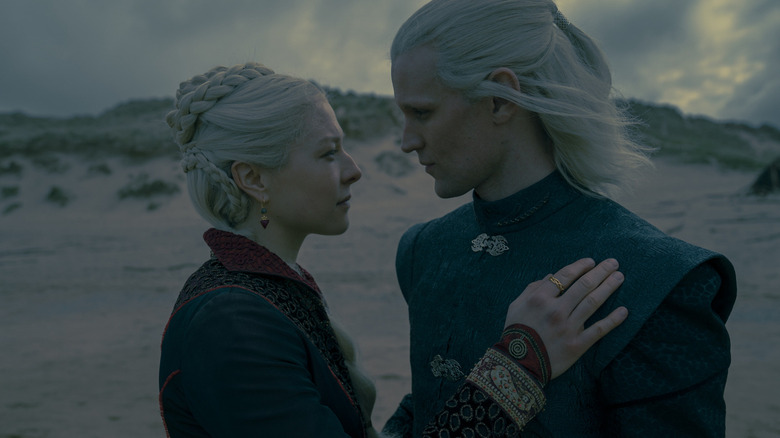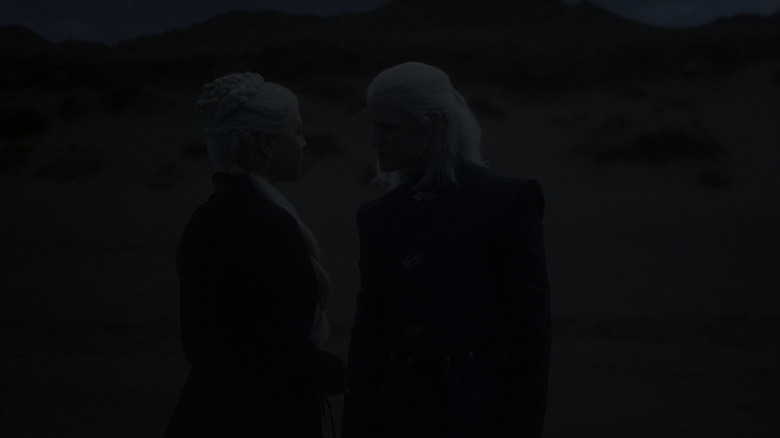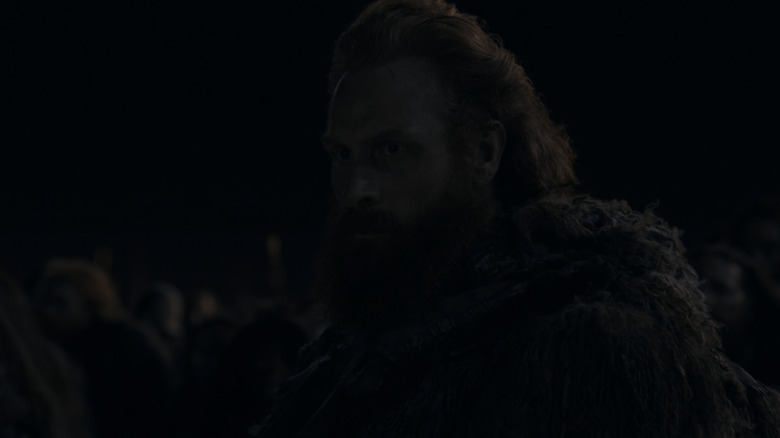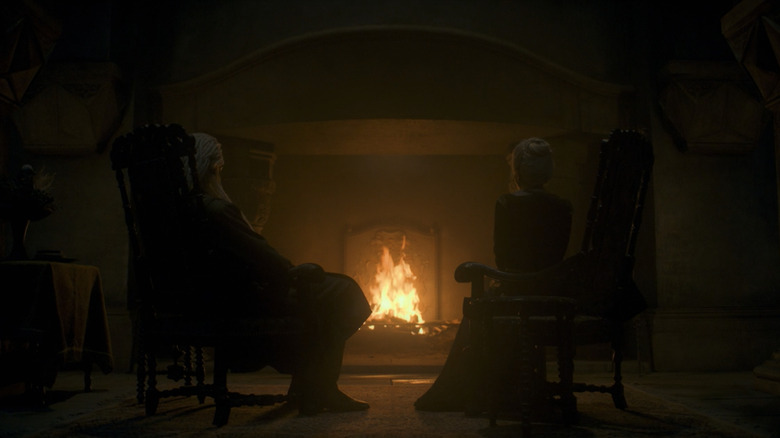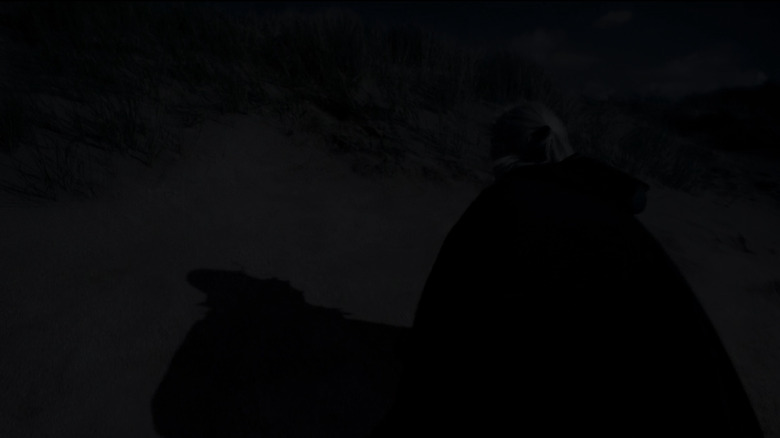Why House Of The Dragon's Nighttime Scenes Look Like Crap
If you threw on the seventh episode of "House of the Dragon" last night to watch your weekly dose of Westerosi power plays and incest, you may have had trouble actually seeing what was happening on screen for about half of the episode. Twitter was home to countless comments about needing to turn up your TV's brightness or just images of people squinting, struggling to see things directly in front of them. It was reminiscent of the response to an episode from the final season of "Game of Thrones" called "The Long Night," which received a massive amount of complaints from people unable to properly see what was going on.
Back when that episode aired, I balked at the complaints. When I watched "The Long Night," I had no issue with how it looked. Yes, it was dark, but it was not murky. The issues with that episode could be solved by people adjusting the settings on their television sets and changing the environment they watch the show in. People think it is an issue with brightness, but it isn't. It's an issue of contrast, and if you adjust that and see it in a dark room, there isn't much of an issue.
My settings had not changed from "The Long Night," as I still use the same TV. However, I could not believe how muddled, dark, and, frankly, ugly the exterior nighttime scenes in "Driftmark" looked. The reason for why each episode is difficult to see are very different though. The issues for "The Long Night" come from shooting at night and wanting to utilize only natural lighting sources for a scene. The issues for "Driftmark" come from a shooting process called "day for night," something usually done as a cost-saving measure. And it almost never looks good.
What is day for night?
Shooting day for night is exactly what it sounds like. It's when you shoot a scene meant that takes place at night during the day. This practice goes back to the earliest days of cinema. Film is a medium of light, and when it was first created, you needed A LOT of light to have any kind of an image captured, as early film stocks weren't incredibly light sensitive. Shooting at night was basically impossible, so filmmakers would instead shoot the scenes during the day and tint the film blue in post-production to simulate nighttime.
Overtime, film stocks got a little faster (more light sensitive), so it was possible to shoot at night. However, it was extremely expensive and time consuming, as it required a great deal of lights that needed to be painstakingly planned. For those that couldn't afford it, they would shoot day for night. What this method turned into was deliberately underexposing the film by several T-Stops and, again, add a blue hue to the scene. This method has almost never looked right. Underexposing your image means sacrificing a tremendous amount of detail, making the scene look murky. You also need to have a massive suspension of disbelief to think that the moon (which is actually the sun) could be this bright. Throw in the blue tint, and nothing about it seems real.
In the digital age, day for night shooting is not nearly as common as it was. Digital sensors are at a point where capturing images with very little light are easier than ever. When day for night does happen, mixing the underexposed shooting with digital tools in post theoretically offer a greater range of latitude with the image. As "House of the Dragon" shows, that's not always the case.
Miguel Sapochnik hates night shoots
Shooting day for night is usually done to minimize the budget of a project, but considering this is "House of the Dragon," the premiere show on HBO, budget doesn't really factor into this decision. Or, at least, I hope it didn't. A connecting factor between this episode of "House of the Dragon" and "The Long Night" is that they were both directed by Miguel Sapochnik and shot by Fabian Wagner.
"The Long Night" was a punishing shoot for everyone involved. It consisted of 11 weeks of night shooting to construct this expansive, multi-layered battle episode. Night shoots aren't fun for anyone involved. Your mental faculties aren't in top form. Your sleep schedule is completely thrown off. Lighting, even with highly sensitive digital cameras, is extremely difficult. Plus, they were dealing with below freezing temperatures, along with high winds, snow, and mud. In the behind the scenes featurette for the episode, Miguel Sapochnik says of the shoot:
"Look at it this way: I never want to do that again. I don't think anybody who did that ever wants to do it again."
Fabien Wagner put it even simpler, saying, "As a DP, I thought, 'F**k.'" It's hard to blame them for feeling that way. After going through that hellish shoot, I imagine them cracking open the script for "Driftmark" and shuddering at seeing how much of the episode takes place at night. I understand them wanting to shoot day for night purely due to a survival instinct.
Practical vs. stylized lighting
Partly why the shoot for "The Long Night" was challenging for Miguel Sapochnik and Fabien Wagner is that they love to shoot with entirely practical lighting. If a room would only be lit by a fireplace in real life, that'll be the only light source in the scene. Unfortunately, the night scenes in "Driftmark" don't have any natural light sources. They take place on an empty beach, free of lamps, lanterns, torches, and the sun. The only practical light sources are the brief moment where the dragon Vhagar threatens Aemond (Leo Ashton) with fire, and the moon, which really doesn't provide much light at all.
Shooting this at night would require Sapochnik and Wagner to abandon their naturalistic lighting preference for something more stylized, illuminating the faces of the actors with unmotivated lighting. While this would be the more successful approach to these scenes, it would fly in the face of their whole methodology for constructing the look of "House of the Dragon."
So, they decide upon day for night. However, in their quest to eliminate unnatural lighting, they actually include the most unnatural one that could possibly exist in these scenes: the sun. This may be news to you, but the sun isn't out at night. You can underexpose and manipulate the image all you want, but the sun is still going to shine as it always does. Depending on the time of day, it can cast harsh, dramatic shadows. Someone backlit by the sun will have their hair illuminated but not their face, and when you underexpose something that already isn't properly illuminated, you lose any modicum of detail that might have been there. In their quest for naturalism, they end up making images that don't look real in the slightest.
The importance of the image
With shows like "House of the Dragon," people can get so caught up in lore and plot, and think that is all that is required to tell a story. Television, like film, is a visual medium though, and sacrificing the quality of what you put on screen takes a toll on people's investment in the story you are trying to tell. The scenes in "Driftmark" that take place on the dark beach feature extremely important, dramatic moments. The cementing of the union between Rhaenyra (Emma D'Arcy) and Daemon (Matt Smith), complete with an incestuous sex scene, shakes up the power dynamics of this Dance of Dragons in a major way. Aemond bonding with Vhagar sets off the truly fantastic showdown that takes up the back half of this episode, which is some of the best stuff this whole season.
However, neither of those things are as powerful as they feel because the things that happen to get us there have been shot in truly abysmal day for night, leaving the audience squinting in their televisions and wondering what is even happening. The saddest part is that it could have been easily avoided by just shooting at night and letting up a little on your commitment to naturalism. Two people talking and having sex on the beach is not the same overwhelming technical clusterf**k of an hour-long battle scene. Miguel Sapochnik may hate night scenes, but sometimes, you have to stay up late if you want something done right. Had these scenes looked good, you could probably argue this being the best episode of the season. As it stands, it is a significant missed opportunity.
